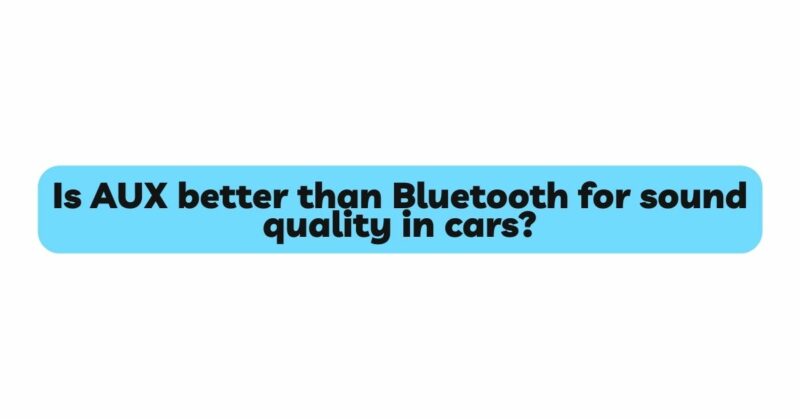The world of in-car entertainment has undergone a technological revolution, offering drivers and passengers a diverse array of options to enhance their driving experience. Among these choices, the battle between AUX (auxiliary) connections and Bluetooth technology for superior sound quality in cars has sparked considerable debate. This article embarks on a comprehensive exploration, delving into the nuances of audio transmission, scrutinizing the attributes and limitations of both AUX and Bluetooth connections, and seeking to address the age-old question: Is AUX truly superior to Bluetooth in terms of sound quality for in-car audio?
The Dual Contenders: AUX and Bluetooth
The showdown between AUX and Bluetooth connections in cars encapsulates the dichotomy between wired and wireless audio transmission. An AUX connection involves a direct, physical link between the audio source (such as a smartphone or music player) and the car’s audio system. On the other hand, Bluetooth technology facilitates wireless audio transmission, offering convenience and adaptability while on the road.
Sound Quality: The Heart of the Matter
The crux of the AUX vs. Bluetooth debate lies in sound quality. Discerning listeners prioritize the ability to immerse themselves in music with clarity, precision, and the full dynamic range. Evaluating sound quality involves assessing parameters such as frequency response, signal-to-noise ratio, distortion, and overall auditory fidelity.
AUX Sound Quality: The Analog Edge
AUX connections, grounded in analog technology, offer several advantages when it comes to sound quality. The direct pathway from the audio source to the car’s audio system ensures minimal interference and maximum fidelity. This translates to a potentially purer audio signal, preserving the nuances and subtleties of the original recording.
The absence of compression in AUX connections further bolsters sound quality. Uncompressed transmission maintains the full dynamic range of the audio, enabling listeners to perceive every whisper and crescendo as intended by the artist. This dynamic range becomes particularly crucial in in-car environments where road noise and engine sounds can compete with the music.
Bluetooth Sound Quality: The Wireless Frontier
Bluetooth audio technology, while introducing wireless freedom, navigates the challenges of maintaining sound quality. Bluetooth operates within the constraints of wireless transmission, involving data compression and potential interference. These factors can impact the overall sound quality experienced by users.
Early Bluetooth codecs, such as SBC (Subband Coding), often introduced perceptible audio degradation due to heavy compression. However, advancements in Bluetooth technology have given rise to higher-quality codecs like aptX, AAC, and LDAC. These codecs aim to deliver audio quality closer to that of wired connections, minimizing data loss during wireless playback.
Compression remains a pivotal concern for Bluetooth audio. While newer codecs mitigate compression artifacts, the nature of wireless transmission necessitates some degree of audio data reduction. This compromise can affect the perceived dynamic range and intricacies of the music, especially for those with finely tuned ears.
Real-World Challenges: The Driving Environment
Evaluating sound quality in cars extends beyond controlled listening environments. In-car audio faces real-world challenges such as road noise, engine vibrations, and cabin acoustics. These factors can mask subtle differences in sound quality between AUX and Bluetooth connections.
In challenging acoustic environments, AUX connections’ potential for superior sound quality becomes more evident. The absence of compression and the direct analog link allow listeners to better discern intricate details in the music. However, advancements in Bluetooth technology are steadily closing the gap, offering more refined wireless audio experiences that account for the intricacies of driving conditions.
Audiophile’s Perspective: Prioritizing Sound Purity
Audiophiles, individuals with an unwavering commitment to sound quality, play a crucial role in the AUX vs. Bluetooth debate. For audiophiles, the goal is to experience music as the artist intended, capturing every nuance and sonic detail. In this context, AUX connections often hold an edge due to their potential to deliver unadulterated sound reproduction.
Bluetooth technology has not gone unnoticed by audiophiles, though. The emergence of high-quality codecs like aptX HD and LDAC has garnered interest, as these codecs strive to minimize compression artifacts and approach the sound quality of wired connections. While the gap narrows, the purist audiophile might still lean towards AUX connections for the ultimate sound purity.
Conclusion: The Balance of Choice
In the ever-evolving landscape of audio technology, the AUX vs. Bluetooth debate doesn’t yield a definitive winner. Both options have their merits, catering to different priorities and preferences. AUX connections promise the potential for superior sound quality through their direct analog pathway and absence of compression. This makes them a preferred choice for audiophiles and those who prioritize unadulterated sound reproduction.
Bluetooth technology, driven by advancements in codecs and wireless transmission, offers convenience, adaptability, and a continuously improving sound quality. While Bluetooth might not yet match the pinnacle of sound purity offered by AUX connections, it caters to the modern driver’s lifestyle, integrating wireless freedom seamlessly into the driving experience.
Ultimately, the choice between AUX and Bluetooth connections boils down to individual preferences and priorities. Those seeking the highest sound quality might opt for AUX connections, while drivers valuing convenience and wireless integration might lean towards Bluetooth. As technology progresses, the differences between the two options continue to narrow, ensuring that listeners can strike a harmonious balance between sound excellence and modern convenience in their in-car audio journey.


